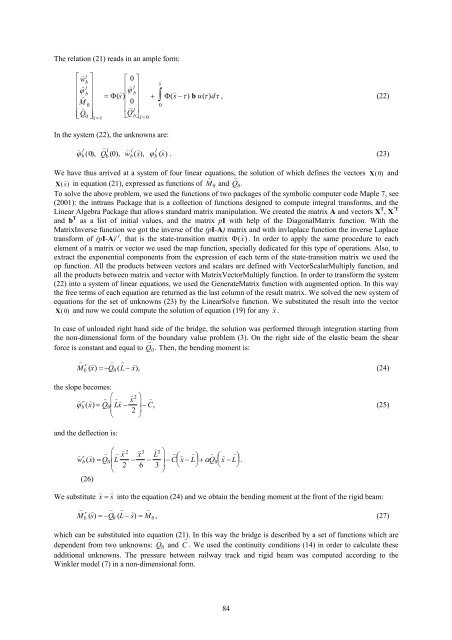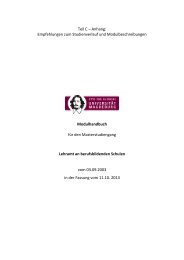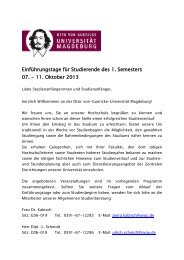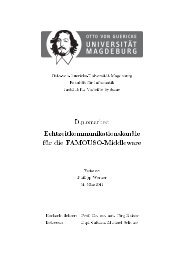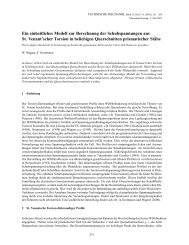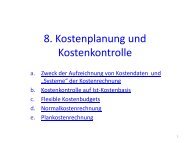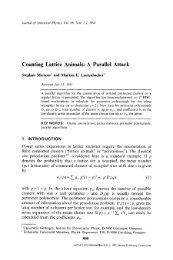Quasi-static Response of a Timoshenko Beam Loaded by an ...
Quasi-static Response of a Timoshenko Beam Loaded by an ...
Quasi-static Response of a Timoshenko Beam Loaded by an ...
Create successful ePaper yourself
Turn your PDF publications into a flip-book with our unique Google optimized e-Paper software.
The relation (21) reads in <strong>an</strong> ample form:<br />
⎡ )<br />
⎢ )<br />
⎢<br />
⎢<br />
)<br />
⎢ )<br />
⎣ ⎢<br />
w b<br />
l<br />
ϕ b<br />
l<br />
⎤<br />
⎥<br />
⎥<br />
⎥<br />
M 0<br />
⎥<br />
Q 0 ⎦ ⎥ )<br />
x = ) s<br />
⎡ 0 ⎤<br />
=Φ( s ) ⎢ ) l<br />
ϕ<br />
⎥<br />
) ⎢ b ⎥<br />
⎢ 0 ⎥<br />
⎢ )<br />
l<br />
⎣ Q b ⎦<br />
⎥<br />
)<br />
x = 0<br />
In the system (22), the unknowns are:<br />
)<br />
ϕ b l (0),<br />
)<br />
s<br />
+ ∫ Φ( ) s −τ ) b u(τ )dτ , (22)<br />
0<br />
)<br />
Q b l (0), ) w b l ( ) s ), ϕ b l ( ) s ) . (23)<br />
We have thus arrived at a system <strong>of</strong> four linear equations, the solution <strong>of</strong> which defines the vectors X(0) <strong>an</strong>d<br />
X( ) s ) in equation (21), expressed as functions <strong>of</strong> M )<br />
0 <strong>an</strong>d Q )<br />
0 .<br />
To solve the above problem, we used the functions <strong>of</strong> two packages <strong>of</strong> the symbolic computer code Maple 7, see<br />
(2001): the inttr<strong>an</strong>s Package that is a collection <strong>of</strong> functions designed to compute integral tr<strong>an</strong>sforms, <strong>an</strong>d the<br />
Linear Algebra Package that allows st<strong>an</strong>dard matrix m<strong>an</strong>ipulation. We created the matrix A <strong>an</strong>d vectors X T , X ’T<br />
<strong>an</strong>d b T as a list <strong>of</strong> initial values, <strong>an</strong>d the matrix pI with help <strong>of</strong> the DiagonalMatrix function. With the<br />
MatrixInverse function we got the inverse <strong>of</strong> the (pI-A) matrix <strong>an</strong>d with invlaplace function the inverse Laplace<br />
tr<strong>an</strong>sform <strong>of</strong> (pI-A) -1 , that is the state-tr<strong>an</strong>sition matrix Φ( x ) ) . In order to apply the same procedure to each<br />
element <strong>of</strong> a matrix or vector we used the map function, specially dedicated for this type <strong>of</strong> operations. Also, to<br />
extract the exponential components from the expression <strong>of</strong> each term <strong>of</strong> the state-tr<strong>an</strong>sition matrix we used the<br />
op function. All the products between vectors <strong>an</strong>d scalars are defined with VectorScalarMultiply function, <strong>an</strong>d<br />
all the products between matrix <strong>an</strong>d vector with MatrixVectorMultiply function. In order to tr<strong>an</strong>sform the system<br />
(22) into a system <strong>of</strong> linear equations, we used the GenerateMatrix function with augmented option. In this way<br />
the free terms <strong>of</strong> each equation are returned as the last column <strong>of</strong> the result matrix. We solved the new system <strong>of</strong><br />
equations for the set <strong>of</strong> unknowns (23) <strong>by</strong> the LinearSolve function. We substituted the result into the vector<br />
X(0) <strong>an</strong>d now we could compute the solution <strong>of</strong> equation (19) for <strong>an</strong>y ) x .<br />
In case <strong>of</strong> unloaded right h<strong>an</strong>d side <strong>of</strong> the bridge, the solution was performed through integration starting from<br />
the non-dimensional form <strong>of</strong> the boundary value problem (3). On the right side <strong>of</strong> the elastic beam the shear<br />
force is const<strong>an</strong>t <strong>an</strong>d equal to Q )<br />
0 . Then, the bending moment is:<br />
)<br />
M b r ( ) x ) =− )<br />
Q 0 ( )<br />
L − ) x ), (24)<br />
the slope becomes:<br />
)<br />
ϕ r b ( x ) ) = Q ) ⎛ )<br />
0 L x ) )<br />
x 2 ⎞<br />
−<br />
⎜ 2 ⎟ − C )<br />
, (25)<br />
⎝ ⎠<br />
<strong>an</strong>d the deflection is:<br />
)<br />
w r b ( ) x ) = ) ⎛<br />
⎜<br />
⎝<br />
(26)<br />
)<br />
Q 0 L<br />
)<br />
x 2<br />
2 − )<br />
x 3<br />
)<br />
6 − L 3 ⎞<br />
3 ⎟ − C ) ⎛<br />
⎜<br />
) x − L<br />
) ⎞<br />
⎟ + α Q ) ⎛ )<br />
⎝ ⎠ 0<br />
⎜ x − L<br />
) ⎞<br />
⎟ .<br />
⎝ ⎠<br />
⎠<br />
We substitute ) x = ) s into the equation (24) <strong>an</strong>d we obtain the bending moment at the front <strong>of</strong> the rigid beam:<br />
)<br />
M r b ( ) s ) =− Q )<br />
0 ( L )<br />
− s ) ) = M )<br />
0 , (27)<br />
which c<strong>an</strong> be substituted into equation (21). In this way the bridge is described <strong>by</strong> a set <strong>of</strong> functions which are<br />
dependent from two unknowns: Q )<br />
0 <strong>an</strong>d C )<br />
. We used the continuity conditions (14) in order to calculate these<br />
additional unknowns. The pressure between railway track <strong>an</strong>d rigid beam was computed according to the<br />
Winkler model (7) in a non-dimensional form.<br />
84


